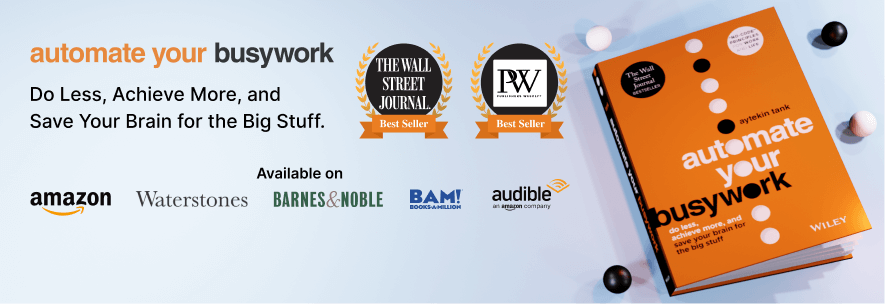When I have a big decision to make, I often think about one of the most famous American poems: The Road Not Taken by Robert Frost. But not for the reason you might expect.
For a long time, I, like many people, believed that the poem was about the life-changing significance of a single decision. After all, the poem ends with the lines:
Two roads diverged in a wood, and I —
I took the one less traveled by,
And that has made all the difference.
But a few years back, I read an article that flipped that reading on its head. As The Paris Review explained, the poem is really getting at the way that we attribute certain decisions with huge consequences. If you re-read the poem, the earlier lines indicate that the two paths were pretty equally traveled. But when we reconstruct the stories of our lives, we pretend that certain decisions are more important than in reality.
So when I’m faced with a tough decision, in life or as CEO of Jotform, I try to keep this takeaway in mind. No matter which path we choose, we’ll figure it out. Decisions aren’t always as consequential as they seem. This helps me get over any false hopes for perfection. It also helps me overcome decision fatigue.
The consequences of too many choices
Each day, we make tens of thousands of decisions. While that figure sounds almost inconceivable, the truth is that we make the lion’s share of those decisions on autopilot — you wake up, brush your teeth, catch the train, and so forth. But each time we deliberate on something — be it a major decision, like whether to accept that job offer or a minor one, like what to eat for breakfast — we spend some of our precious cognitive resources. A growing body of research shows that our decision-making ability worsens after we pass a certain threshold — a phenomenon known as decision fatigue.
Problems arise when weighing your options depletes your mental energy when it comes time to make a consequential decision — when deciding “what to wear” chips away at more important decisions, like “who to hire.” That’s why I try to nip decision fatigue in the bud before it affects my priorities. In addition to letting go of perfectionism and being okay with “good enough,” here are some techniques that have worked for me.
Delegate to the experts
In my role as CEO, I automate as much busywork as possible. But hiring is one of my priorities. I want to personally get to know potential hires and how they’ll work within our dynamic. That’s something that no app or tool can do for me.
The other side of the coin is that once someone is hired, I trust that they’re an expert at their job and committed to our mission. I feel comfortable delegating as many decisions as possible to my team.
Delegating may feel challenging. I get it. You’re protective of your work and want to make sure it gets done properly. If you want something done right, do it yourself. Today, that adage is obsolete. To be a leader in today’s competitive economy, you have to embrace the idea of being more essential and less involved. Delegation is critical for continued growth.
How do you know whether you’re delegating enough?
As Harvard Business Review explains, ask yourself: If I had to take an unexpected week off of work, could key projects advance without me?
When my wife had our second child, I took three full months off. It would have been impossible if I hadn’t gotten comfortable delegating well in advance.
Also, don’t be afraid to delegate decisions in your personal life to save your brain for the big stuff. Take getting dressed: studies have shown that most people feel overwhelmed or stressed when deciding what to wear to events and social gatherings. Clothing choices cause so much stress that a market has popped up for companies, like Stitch Fix, that are dedicated to solving that dilemma.
If a step in your daily routine is tripping you up, from exercising to choosing an outfit, rest assured that there’s a tool or service that can take that decision off your plate.
Automate recurring decisions
Experts have found that decision fatigue isn’t just a matter of being lazy. It stems from actual changes in brain function. What’s more, there may be a “sweet spot” in terms of number of choices and performance. Research using functional magnetic resonance imaging showed that when people were asked to choose from sets of six, 12 or 24 items, activity was highest in the striatum and the anterior cingulate cortex (responsible for various types of cognition) when the people faced 12 choices, aka the “sweet spot.”
In other words, people function well with some choices but get overwhelmed by weighing too many options.
One way to eliminate some of the daily myriad choices is to automate your busywork — all the repetitive, tedious, low-value tasks that clog up your days. This requires taking a hard look at what you do in an average day and identifying all the steps you can automate, rather than doing yourself.
When you automate as many tasks as possible, you spend less time deciding what to do next. And you also slash time deliberating over less meaningful choices. Instead, an automated tool decides for you. For example, rather than mulling over how to reply to common user queries, an AI-powered tool can handle that for you. Instead of figuring out how to identify the latest search trends, you can automatically receive daily Google Trends — Google’s search trends feature — in a spreadsheet ready to be analyzed for search and SEO trends. (My book features an index of automated tools and apps for various types of work.)
Final thoughts
Being an entrepreneur is not for the faint of heart. Sometimes, it can feel like being on a treadmill. We get so focused on making it through the day that we can lose touch with what initially got us running.
When I find myself struggling over big-picture decisions, I take it as a sign that I’ve lost touch with my intuition. In those moments, it’s important to take a step back. To carve out some quiet time and consider my goals and values. How will this decision align with those values? How will it further my goals?
The truth is, most choices won’t change the trajectory of your life. Rare are decisions that you can’t course-correct in the future. In the end, it’s about making the decision-making process painless and saving mental energy for work that matters.













Send Comment: